HRMT20024 Annotated Bibliography: Managing Human Resources in Industry
VerifiedAdded on 2023/06/12
|9
|2178
|111
Annotated Bibliography
AI Summary
This annotated bibliography focuses on managing human resources within the manufacturing industry, drawing from five peer-reviewed journal articles. The introduction sets the stage by highlighting the increasing awareness among small and micro-enterprises regarding the impact of effective HR management on organizational success. The annotated articles cover key HR functions such as compensation management, recruitment, training, performance appraisal, and labor relations, emphasizing their importance in driving results. Furthermore, the bibliography explores HR development, workforce diversity management practices in the Australian manufacturing sector, the importance of HRM policies and practices in addressing worker uncertainties, and the role of equality and anti-discrimination laws in creating a positive work environment. The analysis of these articles provides a comprehensive overview of the challenges and opportunities in managing human resources within the manufacturing industry, underlining the need for ethical practices, diversity, and effective employee management to achieve organizational goals. This student contributed assignment is available on Desklib, a platform providing a wide range of study resources for students.
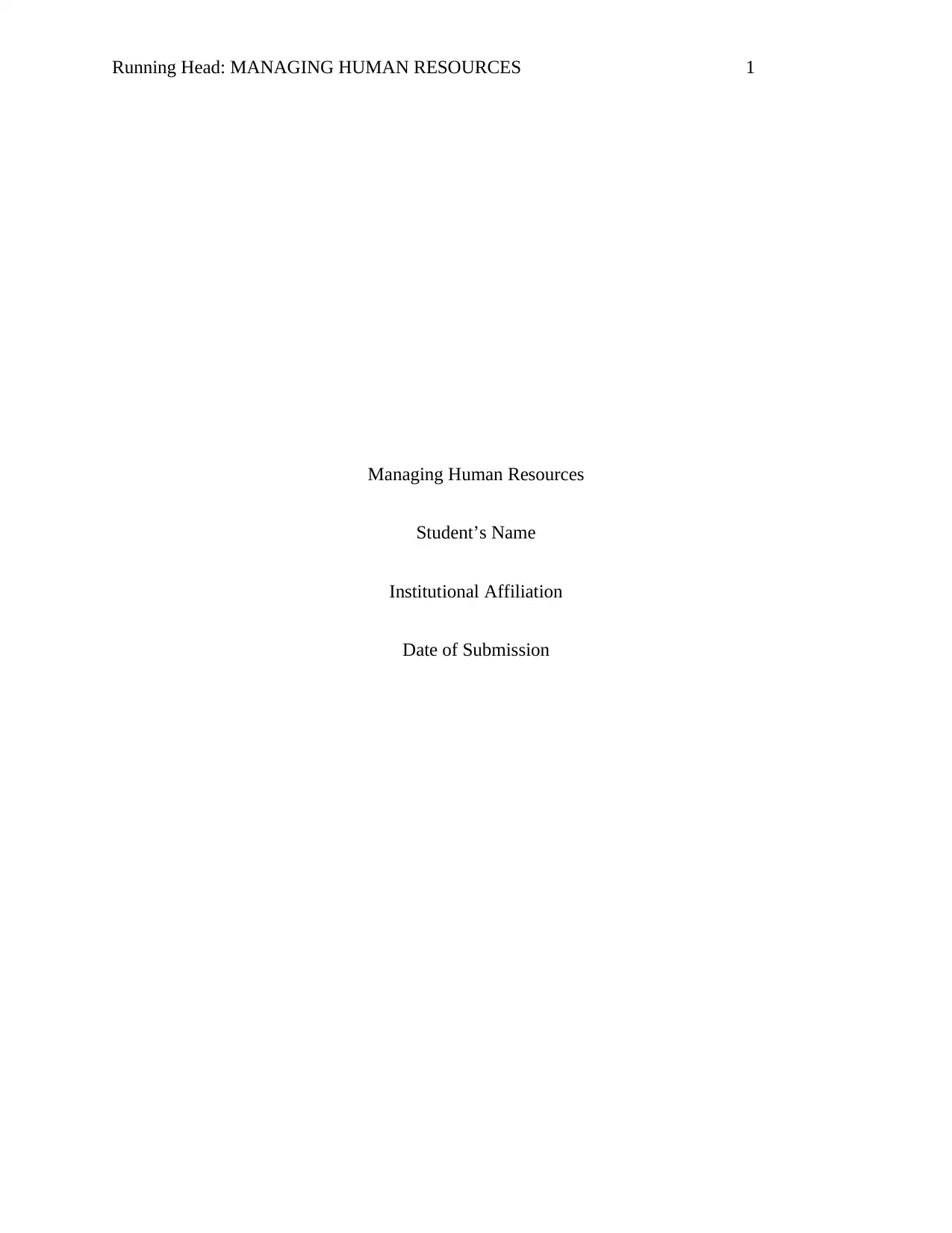
Running Head: MANAGING HUMAN RESOURCES 1
Managing Human Resources
Student’s Name
Institutional Affiliation
Date of Submission
Managing Human Resources
Student’s Name
Institutional Affiliation
Date of Submission
Paraphrase This Document
Need a fresh take? Get an instant paraphrase of this document with our AI Paraphraser
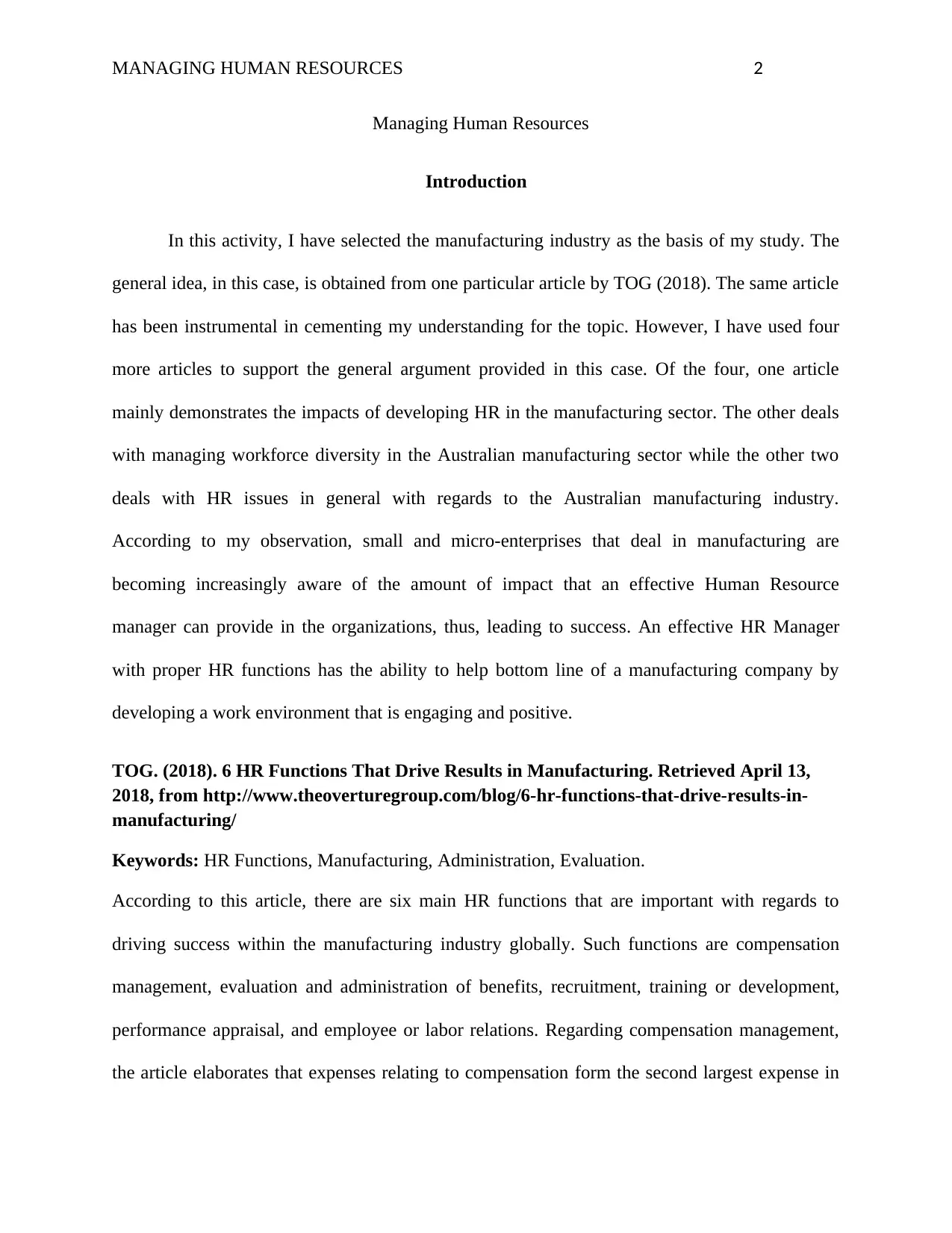
MANAGING HUMAN RESOURCES 2
Managing Human Resources
Introduction
In this activity, I have selected the manufacturing industry as the basis of my study. The
general idea, in this case, is obtained from one particular article by TOG (2018). The same article
has been instrumental in cementing my understanding for the topic. However, I have used four
more articles to support the general argument provided in this case. Of the four, one article
mainly demonstrates the impacts of developing HR in the manufacturing sector. The other deals
with managing workforce diversity in the Australian manufacturing sector while the other two
deals with HR issues in general with regards to the Australian manufacturing industry.
According to my observation, small and micro-enterprises that deal in manufacturing are
becoming increasingly aware of the amount of impact that an effective Human Resource
manager can provide in the organizations, thus, leading to success. An effective HR Manager
with proper HR functions has the ability to help bottom line of a manufacturing company by
developing a work environment that is engaging and positive.
TOG. (2018). 6 HR Functions That Drive Results in Manufacturing. Retrieved April 13,
2018, from http://www.theoverturegroup.com/blog/6-hr-functions-that-drive-results-in-
manufacturing/
Keywords: HR Functions, Manufacturing, Administration, Evaluation.
According to this article, there are six main HR functions that are important with regards to
driving success within the manufacturing industry globally. Such functions are compensation
management, evaluation and administration of benefits, recruitment, training or development,
performance appraisal, and employee or labor relations. Regarding compensation management,
the article elaborates that expenses relating to compensation form the second largest expense in
Managing Human Resources
Introduction
In this activity, I have selected the manufacturing industry as the basis of my study. The
general idea, in this case, is obtained from one particular article by TOG (2018). The same article
has been instrumental in cementing my understanding for the topic. However, I have used four
more articles to support the general argument provided in this case. Of the four, one article
mainly demonstrates the impacts of developing HR in the manufacturing sector. The other deals
with managing workforce diversity in the Australian manufacturing sector while the other two
deals with HR issues in general with regards to the Australian manufacturing industry.
According to my observation, small and micro-enterprises that deal in manufacturing are
becoming increasingly aware of the amount of impact that an effective Human Resource
manager can provide in the organizations, thus, leading to success. An effective HR Manager
with proper HR functions has the ability to help bottom line of a manufacturing company by
developing a work environment that is engaging and positive.
TOG. (2018). 6 HR Functions That Drive Results in Manufacturing. Retrieved April 13,
2018, from http://www.theoverturegroup.com/blog/6-hr-functions-that-drive-results-in-
manufacturing/
Keywords: HR Functions, Manufacturing, Administration, Evaluation.
According to this article, there are six main HR functions that are important with regards to
driving success within the manufacturing industry globally. Such functions are compensation
management, evaluation and administration of benefits, recruitment, training or development,
performance appraisal, and employee or labor relations. Regarding compensation management,
the article elaborates that expenses relating to compensation form the second largest expense in

MANAGING HUMAN RESOURCES 3
business after purchasing or raw materials. HR managers are required to determine the most
appropriate mix for base and variable pay alongside benefits that retain or motivate high
performers in an organization. Under evaluation of benefits as a function, balancing employee
requirements alongside managing the increasing employee benefits costs is an issue that is
sensitive with regards to health insurance. In such a case, HR managers are left to answer several
questions like if to offer different benefit options.
Regarding recruitment, the article claims that the interest of younger generations is reducing with
regards to going for manufacturing career opportunities. Such is because of the current
perception that the manufacturing industry lacks the cutting edge compared to other industries.
Such a case is an industry-wide challenge which requires the skills of an HR manager that is
well-connected and imaginative to give its organization an advantage over others. IN this case,
the most crucial obligation of the HR manager is to effectively recruit individuals that are
talented in a manner that is timely and cost-effective. Regarding training, leaders of HR
departments are required to effectively manage development and training areas within the
organization. Also, regarding performance appraisal as a different function, HR needs to design
as well as implement formal programs of employee appraisal to ensure that tools and processes
are in line with the goals of the organization. Also, HR will provide line managers with the skills
and support they need to engage such processes effectively to ensure that the organization
achieve the results that are desired. The last function described in this article is labor relations.
Under this topic, the argument is that HR leadership with regards to employee and labor relations
is vital in the manufacturing industry. For non-union companies, sustaining such a status would
take much time and effort. However, for those organizations that are unionized, on-going
relations and labor negotiations would have significance on the financials of companies.
business after purchasing or raw materials. HR managers are required to determine the most
appropriate mix for base and variable pay alongside benefits that retain or motivate high
performers in an organization. Under evaluation of benefits as a function, balancing employee
requirements alongside managing the increasing employee benefits costs is an issue that is
sensitive with regards to health insurance. In such a case, HR managers are left to answer several
questions like if to offer different benefit options.
Regarding recruitment, the article claims that the interest of younger generations is reducing with
regards to going for manufacturing career opportunities. Such is because of the current
perception that the manufacturing industry lacks the cutting edge compared to other industries.
Such a case is an industry-wide challenge which requires the skills of an HR manager that is
well-connected and imaginative to give its organization an advantage over others. IN this case,
the most crucial obligation of the HR manager is to effectively recruit individuals that are
talented in a manner that is timely and cost-effective. Regarding training, leaders of HR
departments are required to effectively manage development and training areas within the
organization. Also, regarding performance appraisal as a different function, HR needs to design
as well as implement formal programs of employee appraisal to ensure that tools and processes
are in line with the goals of the organization. Also, HR will provide line managers with the skills
and support they need to engage such processes effectively to ensure that the organization
achieve the results that are desired. The last function described in this article is labor relations.
Under this topic, the argument is that HR leadership with regards to employee and labor relations
is vital in the manufacturing industry. For non-union companies, sustaining such a status would
take much time and effort. However, for those organizations that are unionized, on-going
relations and labor negotiations would have significance on the financials of companies.
⊘ This is a preview!⊘
Do you want full access?
Subscribe today to unlock all pages.

Trusted by 1+ million students worldwide
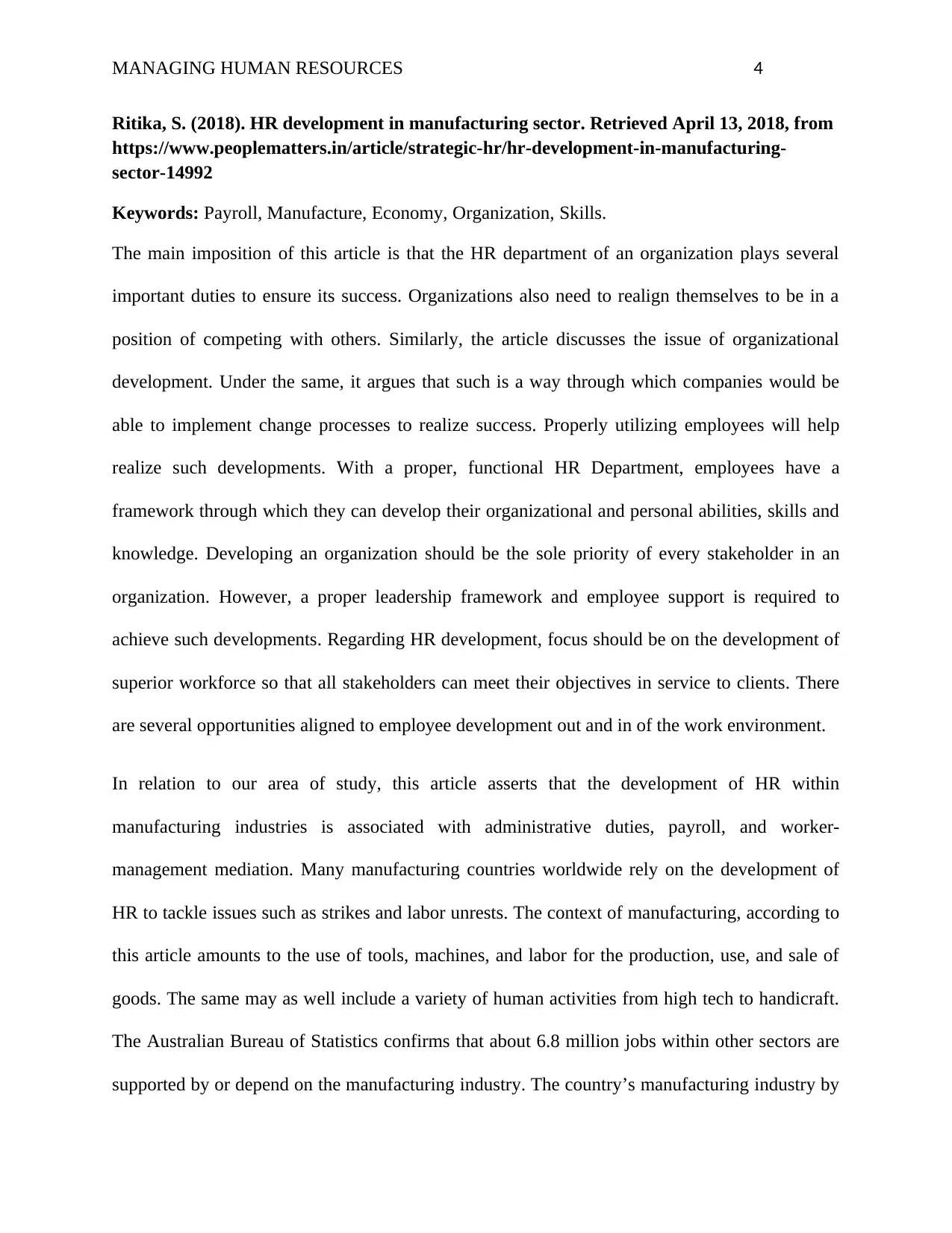
MANAGING HUMAN RESOURCES 4
Ritika, S. (2018). HR development in manufacturing sector. Retrieved April 13, 2018, from
https://www.peoplematters.in/article/strategic-hr/hr-development-in-manufacturing-
sector-14992
Keywords: Payroll, Manufacture, Economy, Organization, Skills.
The main imposition of this article is that the HR department of an organization plays several
important duties to ensure its success. Organizations also need to realign themselves to be in a
position of competing with others. Similarly, the article discusses the issue of organizational
development. Under the same, it argues that such is a way through which companies would be
able to implement change processes to realize success. Properly utilizing employees will help
realize such developments. With a proper, functional HR Department, employees have a
framework through which they can develop their organizational and personal abilities, skills and
knowledge. Developing an organization should be the sole priority of every stakeholder in an
organization. However, a proper leadership framework and employee support is required to
achieve such developments. Regarding HR development, focus should be on the development of
superior workforce so that all stakeholders can meet their objectives in service to clients. There
are several opportunities aligned to employee development out and in of the work environment.
In relation to our area of study, this article asserts that the development of HR within
manufacturing industries is associated with administrative duties, payroll, and worker-
management mediation. Many manufacturing countries worldwide rely on the development of
HR to tackle issues such as strikes and labor unrests. The context of manufacturing, according to
this article amounts to the use of tools, machines, and labor for the production, use, and sale of
goods. The same may as well include a variety of human activities from high tech to handicraft.
The Australian Bureau of Statistics confirms that about 6.8 million jobs within other sectors are
supported by or depend on the manufacturing industry. The country’s manufacturing industry by
Ritika, S. (2018). HR development in manufacturing sector. Retrieved April 13, 2018, from
https://www.peoplematters.in/article/strategic-hr/hr-development-in-manufacturing-
sector-14992
Keywords: Payroll, Manufacture, Economy, Organization, Skills.
The main imposition of this article is that the HR department of an organization plays several
important duties to ensure its success. Organizations also need to realign themselves to be in a
position of competing with others. Similarly, the article discusses the issue of organizational
development. Under the same, it argues that such is a way through which companies would be
able to implement change processes to realize success. Properly utilizing employees will help
realize such developments. With a proper, functional HR Department, employees have a
framework through which they can develop their organizational and personal abilities, skills and
knowledge. Developing an organization should be the sole priority of every stakeholder in an
organization. However, a proper leadership framework and employee support is required to
achieve such developments. Regarding HR development, focus should be on the development of
superior workforce so that all stakeholders can meet their objectives in service to clients. There
are several opportunities aligned to employee development out and in of the work environment.
In relation to our area of study, this article asserts that the development of HR within
manufacturing industries is associated with administrative duties, payroll, and worker-
management mediation. Many manufacturing countries worldwide rely on the development of
HR to tackle issues such as strikes and labor unrests. The context of manufacturing, according to
this article amounts to the use of tools, machines, and labor for the production, use, and sale of
goods. The same may as well include a variety of human activities from high tech to handicraft.
The Australian Bureau of Statistics confirms that about 6.8 million jobs within other sectors are
supported by or depend on the manufacturing industry. The country’s manufacturing industry by
Paraphrase This Document
Need a fresh take? Get an instant paraphrase of this document with our AI Paraphraser

MANAGING HUMAN RESOURCES 5
itself creates more that 10 million jobs. Globally, the sector boasts as the 10th largest economy.
Such, therefore, portrays how the manufacturing industry plays a vital role in the functionality of
the global economy.
Monga, M. (2013). Human resource diversity management practices in the Australian
manufacturing sector. Retrieved April 13, 2018, from
https://www.tandfonline.com/doi/abs/10.1080/09585192.2013.826714
Keywords: Diversity, Management, Communication, Culture.
This article discusses the examination of perceptions of workers regarding the challenges and
benefits of workforce and HR diversity management practices. The practices, in this case, are in
line with the Australian manufacturing industry. According to the study performed in this article,
there is little discrimination in the Australian manufacturing industry. Contrarily, the studies
show that employers in Australia use a ‘legalistic compliance approach.’ At the same time, they
do not considering diversity of the workforce as a way of increasing their competitive advantage.
The practices that employers have adopted are not effective enough to manage HR diversity
practices. Simply put, the manufacturing industry of Australia does not value diversity enough.
The industry also fails to capitalize workforce diversity benefits since it does not recognize
overseas skills, soaring costs of training, ineffective communication, and social isolation as its
main barriers. The article also identifies some major benefits associated with workforce
diversity. Such benefits are cultural interaction and diversity, stronger work ethic, reduced levels
of absenteeism, and reduced labor turnover.
For the global industry, the article is very clear. According to Monga (2013), maintaining ethical
practices and diversity is vital to small and micro organizations in case they would wish to gain
their employees’ loyalty. Training ethical practices has well become a trend in the world of
business. Through such training, stakeholders are able to achieve the vision and mission of their
itself creates more that 10 million jobs. Globally, the sector boasts as the 10th largest economy.
Such, therefore, portrays how the manufacturing industry plays a vital role in the functionality of
the global economy.
Monga, M. (2013). Human resource diversity management practices in the Australian
manufacturing sector. Retrieved April 13, 2018, from
https://www.tandfonline.com/doi/abs/10.1080/09585192.2013.826714
Keywords: Diversity, Management, Communication, Culture.
This article discusses the examination of perceptions of workers regarding the challenges and
benefits of workforce and HR diversity management practices. The practices, in this case, are in
line with the Australian manufacturing industry. According to the study performed in this article,
there is little discrimination in the Australian manufacturing industry. Contrarily, the studies
show that employers in Australia use a ‘legalistic compliance approach.’ At the same time, they
do not considering diversity of the workforce as a way of increasing their competitive advantage.
The practices that employers have adopted are not effective enough to manage HR diversity
practices. Simply put, the manufacturing industry of Australia does not value diversity enough.
The industry also fails to capitalize workforce diversity benefits since it does not recognize
overseas skills, soaring costs of training, ineffective communication, and social isolation as its
main barriers. The article also identifies some major benefits associated with workforce
diversity. Such benefits are cultural interaction and diversity, stronger work ethic, reduced levels
of absenteeism, and reduced labor turnover.
For the global industry, the article is very clear. According to Monga (2013), maintaining ethical
practices and diversity is vital to small and micro organizations in case they would wish to gain
their employees’ loyalty. Training ethical practices has well become a trend in the world of
business. Through such training, stakeholders are able to achieve the vision and mission of their

MANAGING HUMAN RESOURCES 6
organizations. Ethics begin with the assumption that all workers perform their operations in line
with the organization’s moral guidelines. In as much as an organization can be influential or
large, unethical behavior within it can reduce its success levels. Ethical issues may face any
business organization. Therefore, organizations are required to set ethical operation standards
since such is a vital professional practice applied in several sectors of the economy.
Assignment. (2017). The importance of HRM Policies And Practices Business Essay.
Uniassignment.com. Retrieved April 13, 2018, from https://www.uniassignment.com/essay-
samples/business/importance-of-hrm-policies-and-practices-business-essay.php
Keywords: Policies, Conflict, Organization, Community
This article discusses the relevance and importance of HR policies and practices. According to
the article, organizations try to deal with worker uncertainties fast enough before conflicts arise
within the workforce. In relation to tackling issues pertaining to employee-management
relationship, this work addresses the following factors:
a) Avoiding uncertainty: In this case, organizations are encouraged to tackle issues that may
lead to employee uncomfortability, uncertainty, and ambiguity. There are particular
supporting beliefs that organizations should uphold.
b) Individualism and Collectivism
We regard individualism as preference to a particular social model. Such preference is knit
loosely in any given business community. On the other hand, collectivism is the opposite of
individualism and referees to a social model that is knit tightly.
c) Masculinity and Femininity
organizations. Ethics begin with the assumption that all workers perform their operations in line
with the organization’s moral guidelines. In as much as an organization can be influential or
large, unethical behavior within it can reduce its success levels. Ethical issues may face any
business organization. Therefore, organizations are required to set ethical operation standards
since such is a vital professional practice applied in several sectors of the economy.
Assignment. (2017). The importance of HRM Policies And Practices Business Essay.
Uniassignment.com. Retrieved April 13, 2018, from https://www.uniassignment.com/essay-
samples/business/importance-of-hrm-policies-and-practices-business-essay.php
Keywords: Policies, Conflict, Organization, Community
This article discusses the relevance and importance of HR policies and practices. According to
the article, organizations try to deal with worker uncertainties fast enough before conflicts arise
within the workforce. In relation to tackling issues pertaining to employee-management
relationship, this work addresses the following factors:
a) Avoiding uncertainty: In this case, organizations are encouraged to tackle issues that may
lead to employee uncomfortability, uncertainty, and ambiguity. There are particular
supporting beliefs that organizations should uphold.
b) Individualism and Collectivism
We regard individualism as preference to a particular social model. Such preference is knit
loosely in any given business community. On the other hand, collectivism is the opposite of
individualism and referees to a social model that is knit tightly.
c) Masculinity and Femininity
⊘ This is a preview!⊘
Do you want full access?
Subscribe today to unlock all pages.

Trusted by 1+ million students worldwide
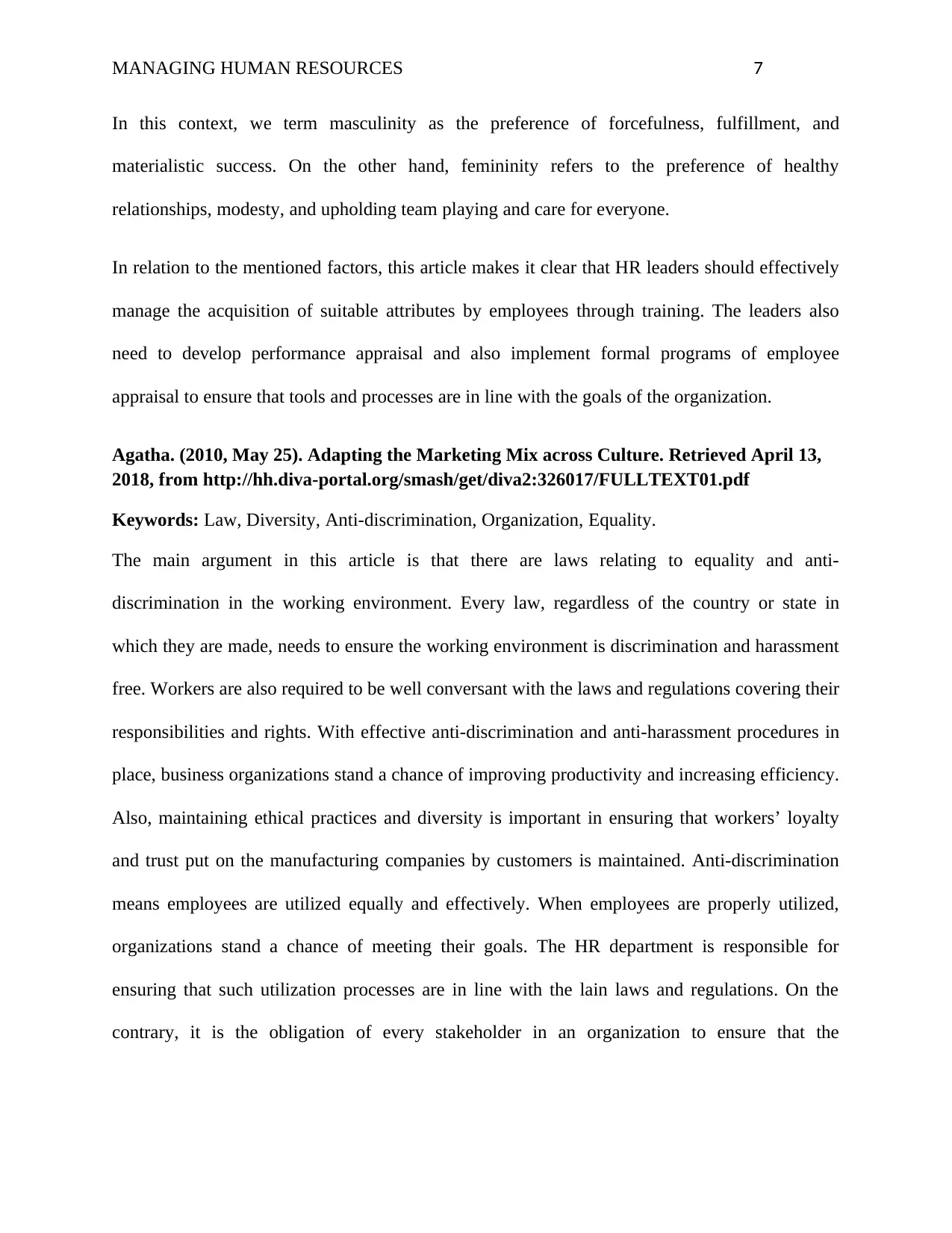
MANAGING HUMAN RESOURCES 7
In this context, we term masculinity as the preference of forcefulness, fulfillment, and
materialistic success. On the other hand, femininity refers to the preference of healthy
relationships, modesty, and upholding team playing and care for everyone.
In relation to the mentioned factors, this article makes it clear that HR leaders should effectively
manage the acquisition of suitable attributes by employees through training. The leaders also
need to develop performance appraisal and also implement formal programs of employee
appraisal to ensure that tools and processes are in line with the goals of the organization.
Agatha. (2010, May 25). Adapting the Marketing Mix across Culture. Retrieved April 13,
2018, from http://hh.diva-portal.org/smash/get/diva2:326017/FULLTEXT01.pdf
Keywords: Law, Diversity, Anti-discrimination, Organization, Equality.
The main argument in this article is that there are laws relating to equality and anti-
discrimination in the working environment. Every law, regardless of the country or state in
which they are made, needs to ensure the working environment is discrimination and harassment
free. Workers are also required to be well conversant with the laws and regulations covering their
responsibilities and rights. With effective anti-discrimination and anti-harassment procedures in
place, business organizations stand a chance of improving productivity and increasing efficiency.
Also, maintaining ethical practices and diversity is important in ensuring that workers’ loyalty
and trust put on the manufacturing companies by customers is maintained. Anti-discrimination
means employees are utilized equally and effectively. When employees are properly utilized,
organizations stand a chance of meeting their goals. The HR department is responsible for
ensuring that such utilization processes are in line with the lain laws and regulations. On the
contrary, it is the obligation of every stakeholder in an organization to ensure that the
In this context, we term masculinity as the preference of forcefulness, fulfillment, and
materialistic success. On the other hand, femininity refers to the preference of healthy
relationships, modesty, and upholding team playing and care for everyone.
In relation to the mentioned factors, this article makes it clear that HR leaders should effectively
manage the acquisition of suitable attributes by employees through training. The leaders also
need to develop performance appraisal and also implement formal programs of employee
appraisal to ensure that tools and processes are in line with the goals of the organization.
Agatha. (2010, May 25). Adapting the Marketing Mix across Culture. Retrieved April 13,
2018, from http://hh.diva-portal.org/smash/get/diva2:326017/FULLTEXT01.pdf
Keywords: Law, Diversity, Anti-discrimination, Organization, Equality.
The main argument in this article is that there are laws relating to equality and anti-
discrimination in the working environment. Every law, regardless of the country or state in
which they are made, needs to ensure the working environment is discrimination and harassment
free. Workers are also required to be well conversant with the laws and regulations covering their
responsibilities and rights. With effective anti-discrimination and anti-harassment procedures in
place, business organizations stand a chance of improving productivity and increasing efficiency.
Also, maintaining ethical practices and diversity is important in ensuring that workers’ loyalty
and trust put on the manufacturing companies by customers is maintained. Anti-discrimination
means employees are utilized equally and effectively. When employees are properly utilized,
organizations stand a chance of meeting their goals. The HR department is responsible for
ensuring that such utilization processes are in line with the lain laws and regulations. On the
contrary, it is the obligation of every stakeholder in an organization to ensure that the
Paraphrase This Document
Need a fresh take? Get an instant paraphrase of this document with our AI Paraphraser
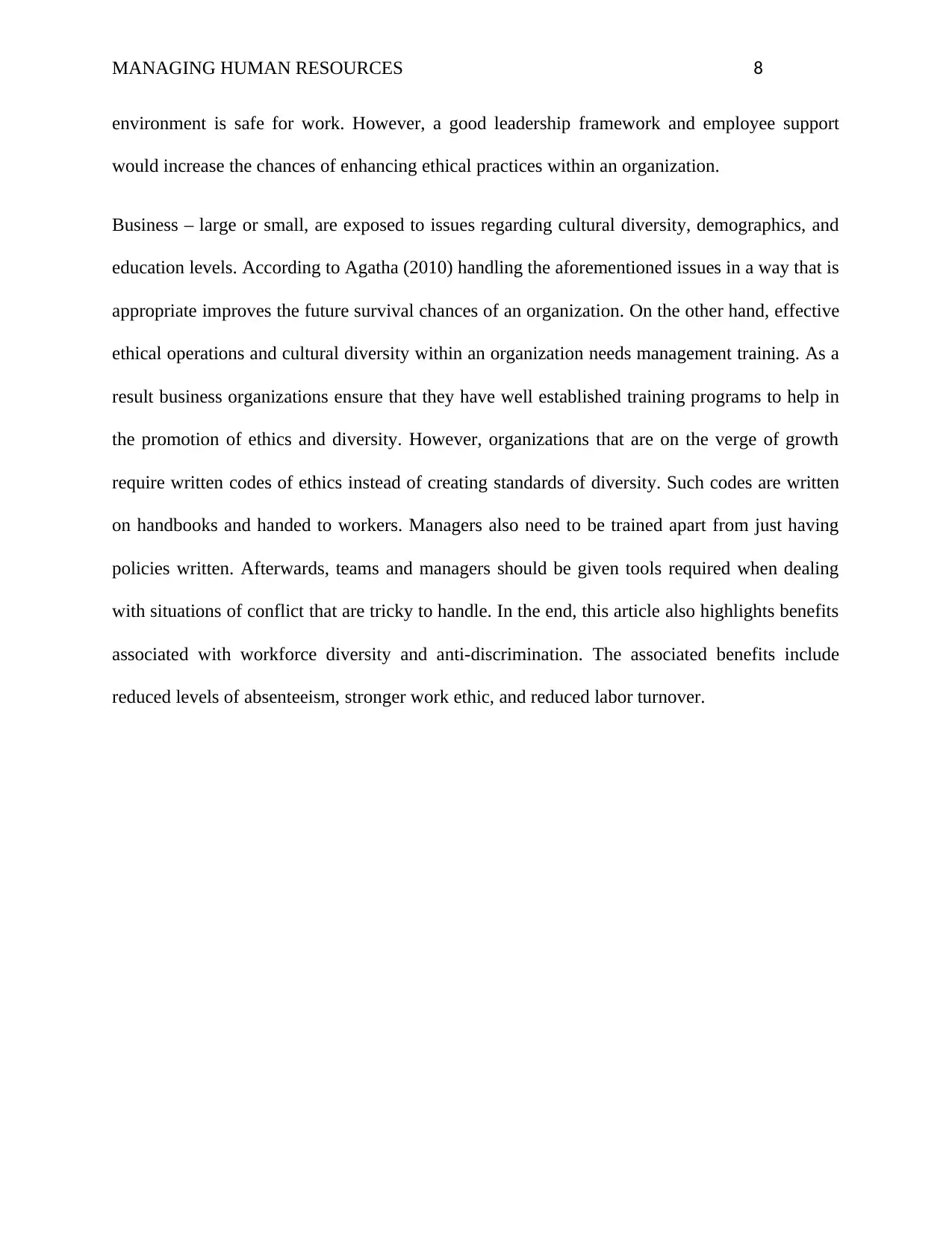
MANAGING HUMAN RESOURCES 8
environment is safe for work. However, a good leadership framework and employee support
would increase the chances of enhancing ethical practices within an organization.
Business – large or small, are exposed to issues regarding cultural diversity, demographics, and
education levels. According to Agatha (2010) handling the aforementioned issues in a way that is
appropriate improves the future survival chances of an organization. On the other hand, effective
ethical operations and cultural diversity within an organization needs management training. As a
result business organizations ensure that they have well established training programs to help in
the promotion of ethics and diversity. However, organizations that are on the verge of growth
require written codes of ethics instead of creating standards of diversity. Such codes are written
on handbooks and handed to workers. Managers also need to be trained apart from just having
policies written. Afterwards, teams and managers should be given tools required when dealing
with situations of conflict that are tricky to handle. In the end, this article also highlights benefits
associated with workforce diversity and anti-discrimination. The associated benefits include
reduced levels of absenteeism, stronger work ethic, and reduced labor turnover.
environment is safe for work. However, a good leadership framework and employee support
would increase the chances of enhancing ethical practices within an organization.
Business – large or small, are exposed to issues regarding cultural diversity, demographics, and
education levels. According to Agatha (2010) handling the aforementioned issues in a way that is
appropriate improves the future survival chances of an organization. On the other hand, effective
ethical operations and cultural diversity within an organization needs management training. As a
result business organizations ensure that they have well established training programs to help in
the promotion of ethics and diversity. However, organizations that are on the verge of growth
require written codes of ethics instead of creating standards of diversity. Such codes are written
on handbooks and handed to workers. Managers also need to be trained apart from just having
policies written. Afterwards, teams and managers should be given tools required when dealing
with situations of conflict that are tricky to handle. In the end, this article also highlights benefits
associated with workforce diversity and anti-discrimination. The associated benefits include
reduced levels of absenteeism, stronger work ethic, and reduced labor turnover.
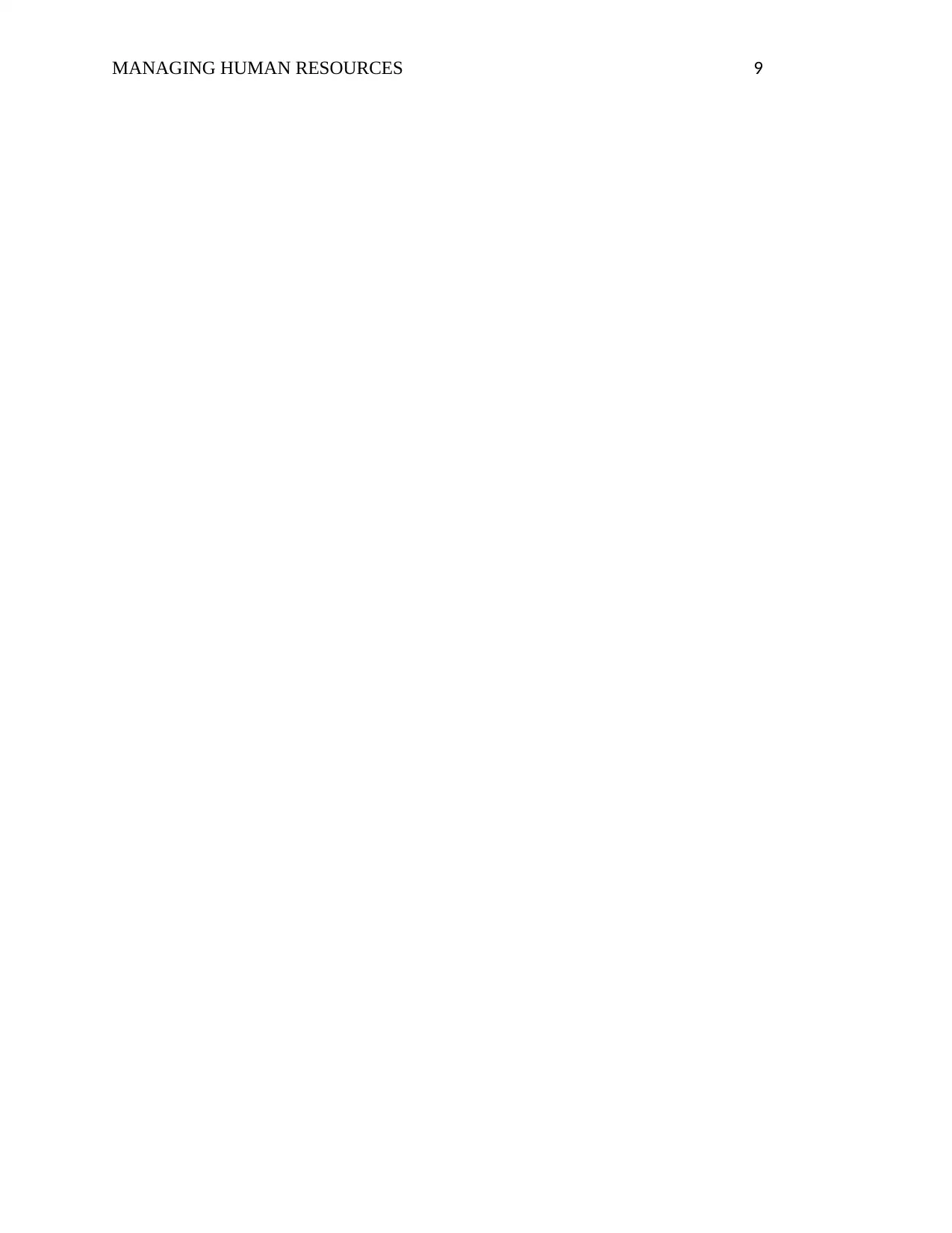
MANAGING HUMAN RESOURCES 9
⊘ This is a preview!⊘
Do you want full access?
Subscribe today to unlock all pages.

Trusted by 1+ million students worldwide
1 out of 9
Related Documents
Your All-in-One AI-Powered Toolkit for Academic Success.
+13062052269
info@desklib.com
Available 24*7 on WhatsApp / Email
![[object Object]](/_next/static/media/star-bottom.7253800d.svg)
Unlock your academic potential
Copyright © 2020–2025 A2Z Services. All Rights Reserved. Developed and managed by ZUCOL.




